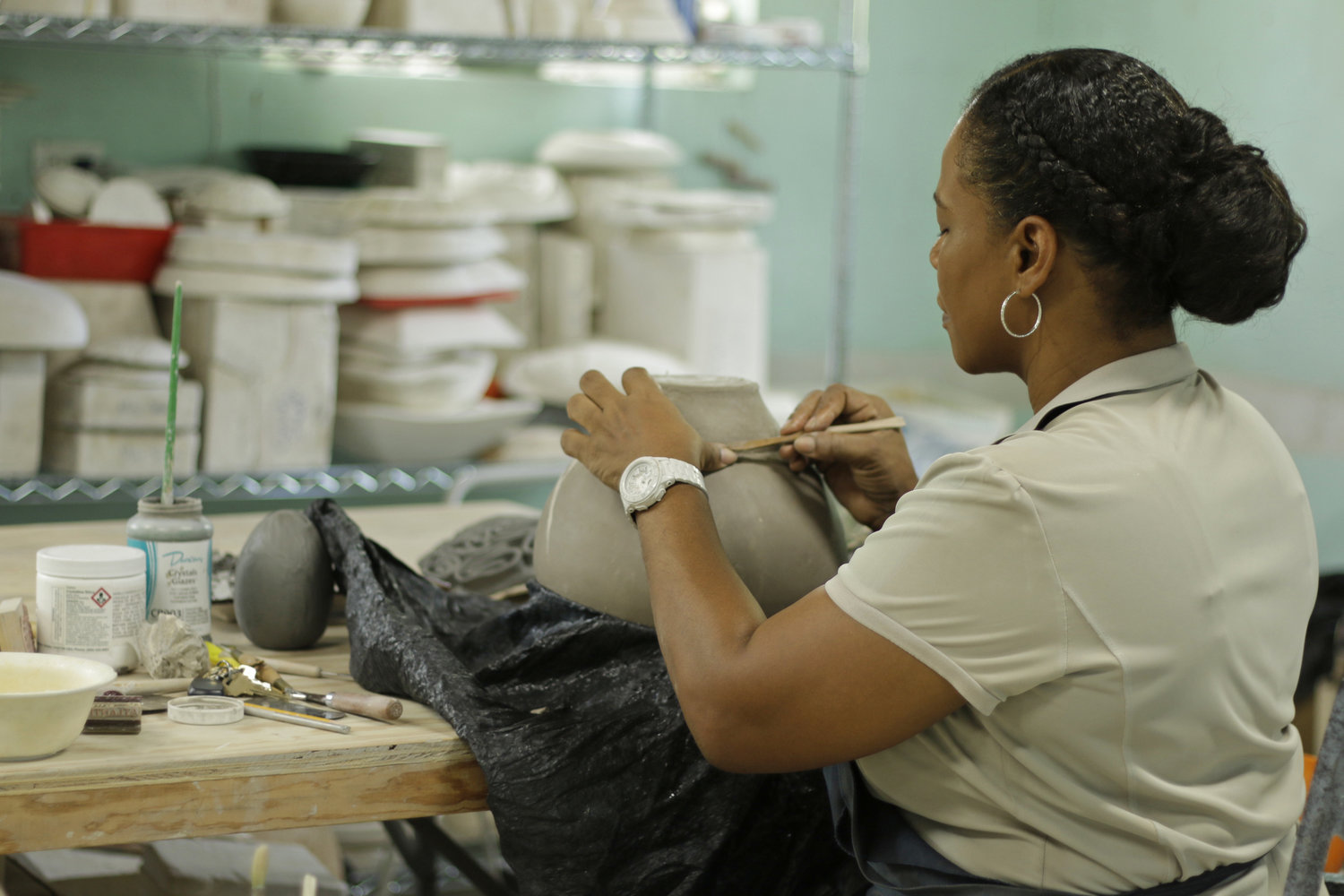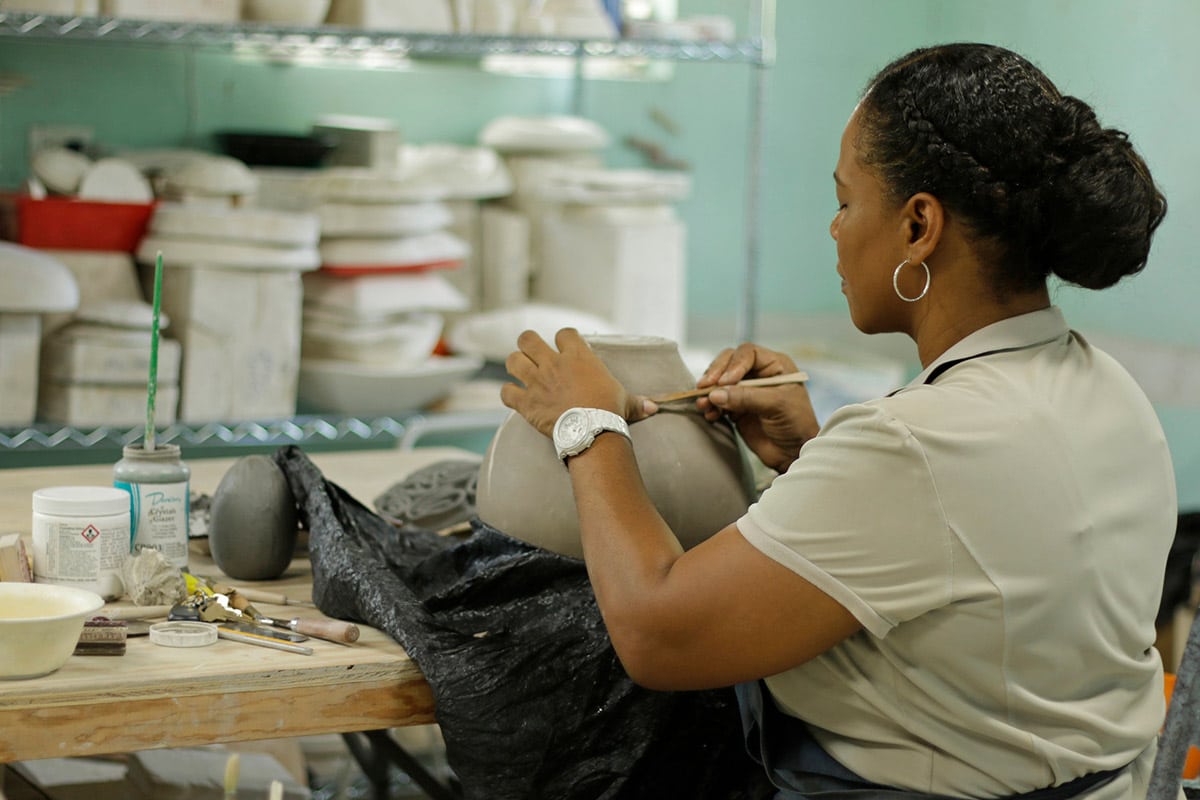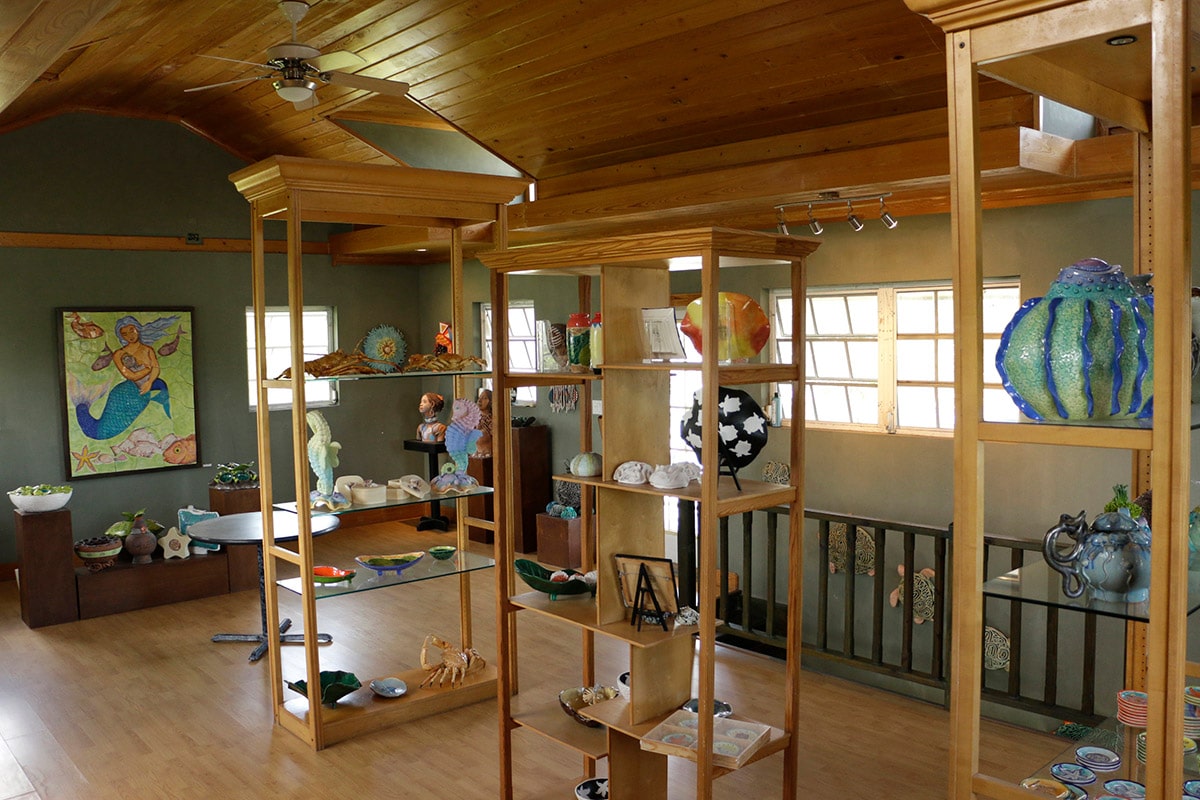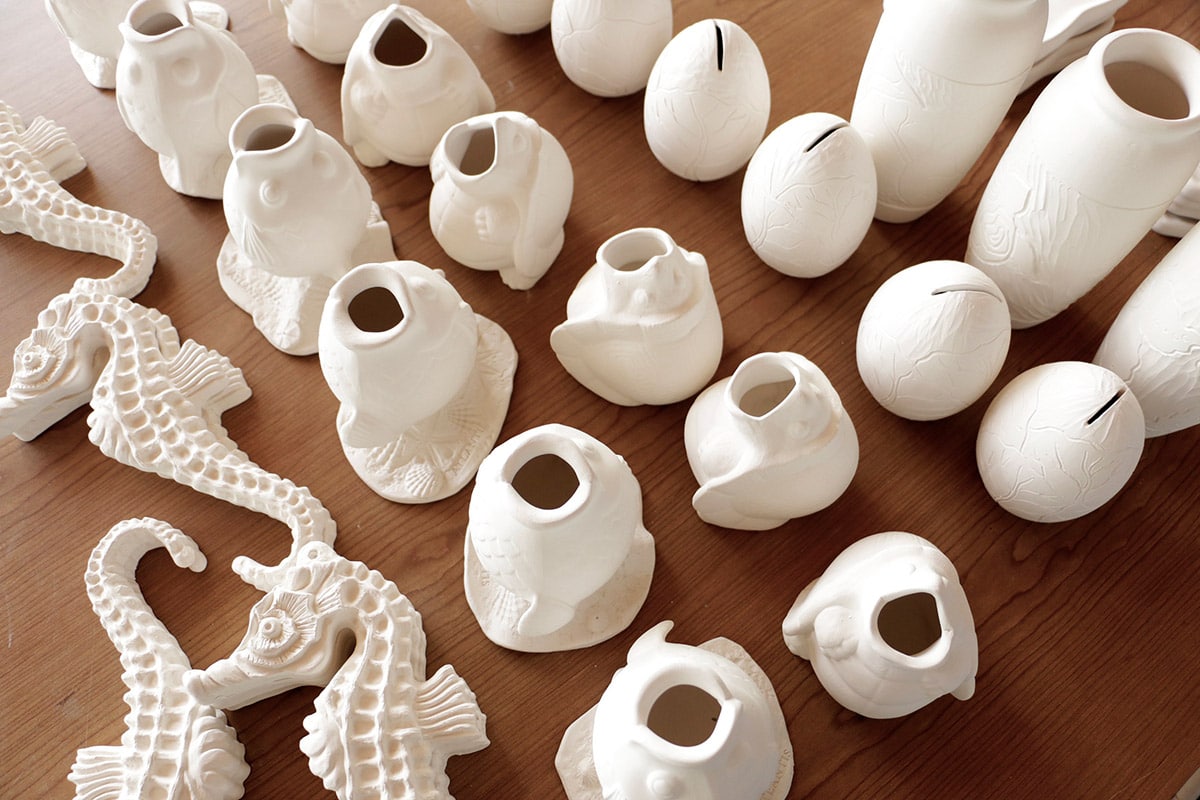
By Keisha Oliver.
Five days a week, you’ll find Bahamian ceramicist Jessica Colebrooke in her Nassau studio, which is tucked away behind her home in the Gleniston Park community. 19 years ago, Colebrooke started out in a 10 x 10ft room with a sheet of plywood on two crates and a small kiln. Today she owns and manages “Jessica’s Tileworks Studio,” one of the leading ceramics and tile manufacturers in The Bahamas. As a mother, wife, educator, artist and entrepreneur, Colebrooke has committed her life and work to supporting and nurturing a culture of creativity.

Jessica Colebrooke working in her ceramics studio (Jessica’s Tileworks Studio in Gleniston Park, Nassau, The Bahamas. (Photo by Keisha Oliver)
Keisha Oliver: When did you first realise you wanted a future in ceramics?
Jessica Colebrooke: I realised my love for ceramics when I was a second year student at The College of The Bahamas (COB). Since high school, my love and passion for painting was always drawn towards realism. To visually see something and to recreate it exactly was a challenge and I love challenges. At the time (early ’90s) I researched and met some of the major Bahamian artists including Brent Malone, Antonius Roberts, Ralph Harris, Eddie Minnis and others. I enrolled at COB still in awe of realism, but I found myself surrounded by students and emerging artists with interests in abstract art and educators who were pushing for students to embrace a wider variety of art forms. I appreciated the styles but they weren’t for me. In my second year at COB, it was in my ceramics course that I realised how much freedom the medium gave me.
KO: How would you describe the emergence of ceramic art in The Bahamas?
JC: Our history dating back to the Arawaks and Chelsea Pottery in the ’50s is fading, because there is not much reference material left from that time. So, I’ve always quoted Denis Knight as the driving force of ceramics in The Bahamas. Knight lived and worked in The Bahamas since the ’50s teaching in the public schools and at COB. Unlike, Chelsea Pottery, which was known as a space for producing commercial pieces, Knight pushed ceramics in the arena of fine art. His work always had a unique and expressive quality. In the ’90s, just before I left for Rhode Island School of Art and Design (RISD), the artists who I knew were practicing included Joann Behagg, Sue Bennett-Williams, and Sabrina Glinton.
KO: You are known as the first female tile manufacturer in The Bahamas. Why do you think there seems to have been a shift from the Denis Knights, Maxwell Taylors and Brent Malones to a modern reality where women dominate the ceramics practice?
JC: When I was a student at COB, there were a few practicing, female working as ceramicists like Joan, Sue, Sabrina and even Sonia Isaacs. So here you had these women who were making their contribution, but rarely recognized. I’ve realized one of the main reasons is that male artists tend to self-promote more than women. From my experience the woman’s role as a mother, wife and homemaker has played an important part in why women are not as visible in ceramics and the arts in The Bahamas. A lot of women of my generation and before had to wait until their children were grown to focus on their creative practice. So, while a male artist may spend a lot of his time in his studio a female artist is divided. I’m divided. The reason why I’m able to get my work out is because I sacrifice the time and spend many nights in my studio.

Showcase area and gallery at Jessica’s Tileworks Studio (Photo by Keisha Oliver)
KO: What do you feel are the qualities that determine the success of an artist in The Bahamas? Do you feel biases in gender, age or otherwise exist?
JC: Success is a personal thing. Once you’ve set goals and achieve them you are successful. A Bahamian artist who may be living and working abroad is not necessarily more successful than the artist who is doing the same here in The Bahamas. Biases like racism will always exist. These are hurdles that we should learn from. I have experienced gender bias in the art community. Individuals and entities that should be neutral in providing equal opportunities often lean toward promoting and supporting male artists more. My advice to women is to focus on what you are doing, promote and invest in yourself, and be dedicated so that you can navigate your progress and positioning in this community.
KO: Is there a market for ceramics in The Bahamas? Does it have a sustainable future?
JC: Before I went off to RISD there wasn’t. In Nassau artists were only holding exhibitions, but in Treasure Cay Karen Mcintosh had been running Abaco Ceramics a commercial ceramics studio since the early ’80s. While finishing my degree, I grew spiritually and one of the things I asked of God was that I wanted to return home to be more than simply a teacher, I wanted to be a working artist like Antonius Roberts and Brent Malone. In my senior year, I studied Henry Mercer for my thesis. He was one of the founding fathers of the arts and crafts movement in the US in the late 1800s. He also created a sustainable market for pottery and tile manufacturing. I realised that his model was something I wanted to bring to The Bahamas.
My vision for “Jessica’s Tileworks Studio” (JTS) started there. I wanted to bring a unique artistic flair to the commercial products. After returning from RISD there was a blossoming season. The pioneers like Sue and Joan still practiced, but artists like Imogene Walkine, Trevor Tucker, Katrina Cartwright also emerged. There is still a lot room for the industry to evolve. I see Bahamian artists like Anina Major and Alistair Stevenson as contemporaries who are working toward this. The financial and technical obligations to the craft make it an unattractive venture for many, but slowly we see through exhibitions and manufacturing there is a market and a future.

Pre-fired bisqueware by Jessica Colebrooke commissioned by Atlantis Resort’s Earth and Fire Pottery Studio (Photo by Keisha Oliver)
KO: How is your studio organised?
JC: JTS is a two-story facility with a ground floor production area, an outdoor kiln area, and an upper floor gallery and showcase space. I work more than I play, but always make time for my children. I work alongside a team who focuses on the commercial brand, but I also contract artists and students to work on specific projects. I was commissioned to produce tiles for the Stix Noodle Bar at Baha Mar. A small group of artists worked on this project with me. Those are the things I’m concerned about, creating creative and financial opportunities geared toward collaboration.
KO: What are you currently working on in your studio?
JC: The studio is always busy. I’m working on developing a collection for a 2018 exhibition, my team is filling orders for clients and distributors, and we’re working on a new project with Atlantis. The resort has been recently promoting and supporting Bahamian individuals and businesses and I was commissioned to produce pieces for its’ Earth and Fire Pottery Studio. The venture is going well, because I think tourists realise that they aren’t just acquiring a souvenir, but buying an authentic Bahamian piece of art they aren’t able to get anywhere else in the world. Here you have this corporate giant identifying a local artist they want to take a chance on. I’m excited about this partnership because it is a challenge that introduces the JTS brand to a new area of manufacturing.